How to take care of Lavender Plants Indoors effectively
As an herb, lavender can be utilized to create aromatic oils, flavor teas, enhance the appearance of rooms, and fill your home with a pleasant aroma. Because of the plant’s popularity, many gardeners have developed an approach for prolonging the growing season of this perennial plant. Growing lavender indoors throughout the winter is a feasible alternative for people who live in places with severe winters. When the weather cools off, move the herbs inside the containers you placed outside. Let’s take a deep dive into how to take care of lavender plants indoors.
If you haven’t got an outdoor garden yet, starting an indoor herb garden with lavender transplants from your neighborhood garden center is a great option. Use these nine suggestions to ensure your lavender plants grow well and are cared for indoors.
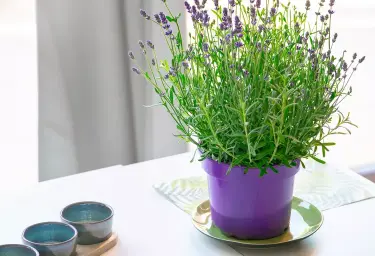
1. Choose Dwarf Types of Lavender plants for Indoor Growing
Since there are around 450 kinds of lavender that you can choose from, it’s crucial to select the kind that best matches your needs when growing lavender indoors. Grow ‘Hidcote’ English lavender (Lavandula angustifolia) for compact, pleasant flowers that will fill your indoor areas all year long. The flowers are densely packed with deep purple blooms. ‘Munstead’ English lavender is an excellent choice if you’ve been looking for a lavender variety with delicate, sweet leaves for culinary reasons. For creating decorative lavender stems in a tabletop arrangement, think about growing ‘Kew Red’ or Spanish lavender, known for its beautiful flowers. Although French lavender (Lavandula dentata) is visually appealing with its serrated leaves, it is less ideal for culinary purposes.
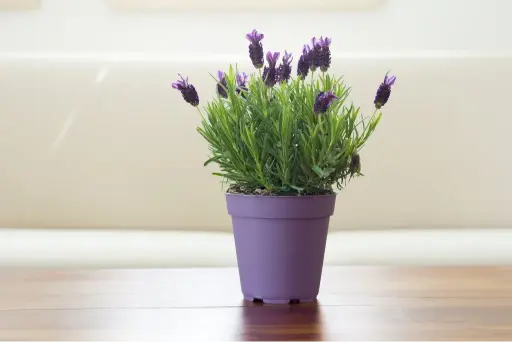
2. Purchase Plants from Your neighborhood Garden center
Purchasing small potted plants or transplants is the simplest way to begin growing lavender indoors, as lavender seeds tend to be difficult to sprout. Plant your new lavender plant in a container that is one or two sizes larger than the last one when you carry it home. Because the plant loves somewhat drier circumstances and water evaporates more quickly from the porous texture of the container, growing lavender in terra-cotta pots is very beneficial.
3. Propagate cuttings:
You can also bring herbs from your balcony garden inside to repot them to extend the growth season indoors. Take your lavender indoors as soon as the temperature dips below 40°F to protect it from cold damage.
Take a few clippings from the lavender plant rather than bringing the full plant indoors. Simply trim off all the leaves from the lowest inch of the stem, measuring three inches from the tip of the stem. Next, place the stem into a potting mix that is sandy and uniformly damp.
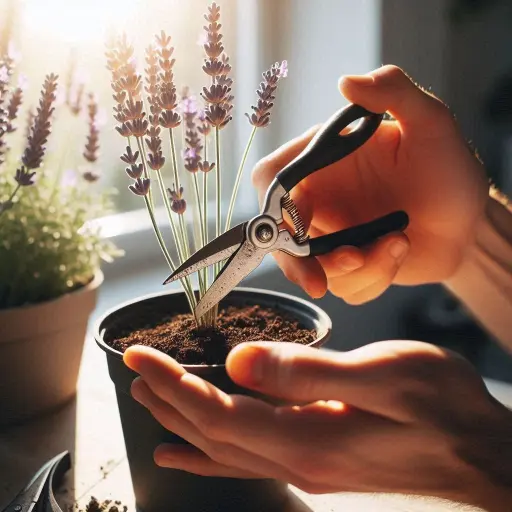
4. Provide Plenty of Light
To ensure your lavender plant receives enough light, position it in a warm location during the summer and a bright, slightly cooler spot in the winter. A kitchen windowsill with southern exposure is often perfect for indoor lavender growth, providing easy access, sufficient light, and air circulation. Rotate the plant weekly to ensure all sides receive six to eight hours of direct sunlight. Consider using grow lights for 12 to 14 hours daily if natural light is insufficient.
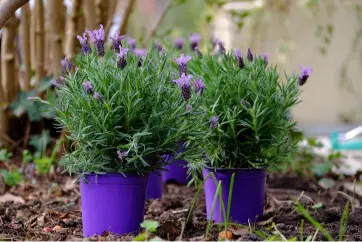
5. Water Lavender When the Soil Feels Dry
Water Lavender Only When Soil Feels Dry You should only water your lavender when the soil feels dry on the surface. Refrain from allowing the plant to remain in soggy soil, as overwatering might cause decay and insect issues. In between waterings, allow the soil to become somewhat dry.
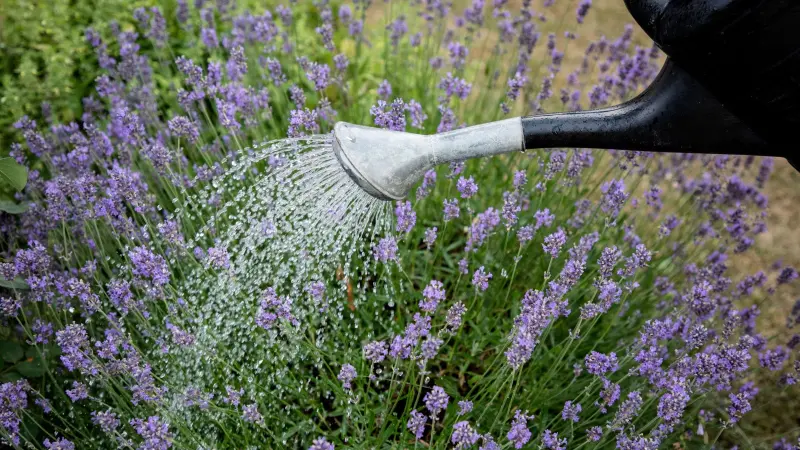
6. Control the Indoor Temperature
Manage the interior temperature to cultivate lavender in the best possible circumstances. Keep the temperature inside your home between 60° and 70°F during the day and at least 10° lower at night. Avoid placing the plant near cold gusts or forced air heating.
7. Continue to Keep Humidity Low
Because lavender grows best in low-humidity environments, houses with relative humidity levels of about 40% are ideal for growing lavender. The average humidity level in houses is ideal for growing lavender, so there’s no need to utilize rock trays or place the plants in high-moisture regions.
8. Prune Carefully
To shape the plant and promote new development, it is recommended to delicately trim the tops of the branches with clean, sharp garden scissors or pruners. Lavender is best pruned in the spring, and cutting the stems back to approximately half their original length encourages new development when the plant is around three or four years old and looks to be declining in the center. You may use lavender all year round if you grow it indoors.

9. Gather Flowers to Infuse Taste into Food and Adorn Your House
The scent of the blooms may soon fade if you wait to harvest the flower spikes until they are at their peak, barely opened, as this will conserve the vital oils. Lavender stems can be cut into full stems and left to dry, which works well for wreaths, sachets, potpourri, and other decorations. Once the flowers are completely dry, you can use the individual buds by removing them from the stems and adding them to butter, cakes, biscuits, meat rubs, and lemonade.

Conclusion
It takes careful consideration of certain requirements, especially light, watering, and soil conditions, to grow lavender well inside. Since lavender needs strong, direct sunshine to grow healthily, it must be placed next to a south-facing window or grown under grow lights for at least 6 to 8 hours per day. It’s crucial to stay away from extremely humid conditions since proper air circulation also aids in the prevention of fungal problems.
Since lavender requires soil that drains well, waterlogging can be avoided by using a potting mix that contains sand or perlite. Watering should only be done when it feels as though the top inch of soil is dry. Lavender does not do well in extremely wet conditions and can withstand drought.

